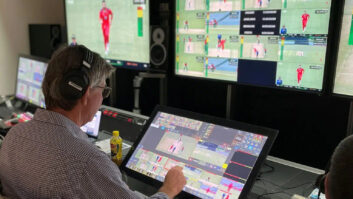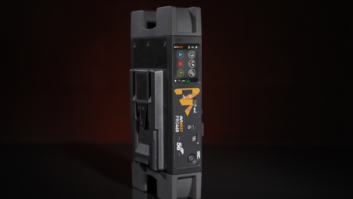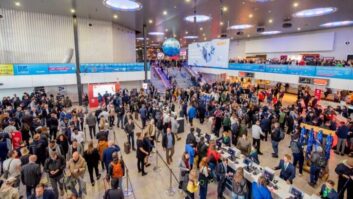From the time nations started going into lockdown, there has been an obvious increase in production from home deployments. This has given rise to some obvious changes. Key among them the move to a software-based – almost mobile – production workflow. That said, the actual production is only one end of the equation – presenter and guest roles have also experienced a transformation.
Traditionally, there were only two types of cameras open to producers for broadcast: pan-tilt-zoom (PTZ) cameras and traditional studio box cameras, usually partnered with robotics and/or camera operators. Prior to Covid-19 we saw the shift toward transporting AV signals over IP, both on public and private networks, but the adoption rate was far from 100 per cent.
But now we are in a full transformation of what our workflows look like. Whereas remote journalists would on occasion use video conferencing technologies to bring one-person crews into production via a desktop computer or mobile handset, today the process is basically standard.
Covid-19 has prompted a wider adoption in technologies we previously saw used only out of necessity – or in particular cases. Now, a wider net of teleconferencing tools have been discovered, utilised, and standardised for increased scalability in our production workflows.
It is one example of how we are adapting to the times – and it should be the expectation that these changes will stay with us for the long haul. To say it succinctly, the blurring between broadcast and AV is now in full acceleration mode – and technologies from both sectors are interoperating like never before.
Hand in hand with this, audience expectations of what is acceptable for production, and the methods of delivery, are wider than ever – proving that content remains king, no matter how it is produced!
Thus, what will the coming months and years look like in terms of evolving productions? How will our remote broadcast – and, even, scripted television – evolve? And more importantly: what technologies must we consider now to ensure there is no stop to the signal? What challenges still lay ahead? As we look to build the next production workflow, consider the following.
Mobile devices
Alongside the general shifts outlined already, it appears brute force has been applied to what is deemed ‘broadcast standard.’ When partnered with efficient, modern compression technologies, mobile cameras and sensors are now capable of delivering exceptional image quality. This is a monumentally important consideration as we look at increasingly remote workflows.
Meanwhile, on the delivery side, we’ve long believed that audiences no longer consider the TV where they watch and consume content. Audiences view all screens – TVs, computers, cinemas, and mobile devices such as tablets and phones – as all the same. A screen to view everything on, no matter where they are.
This results in a mobile-to-mobile workflow consideration. Should we be altering images as they come in to fit traditional definitions of aspect ratios? Or should we be considering ways to simplify the delivery process? The potential now exists to make live content as seamless as a video chat between the device of the newscaster and viewer – and that is a significant concept worth thinking on!
Connective fabric
Once we’ve solved the challenges of production and the presenter/guest/contributor equation, the next hurdle is getting back to transmission. Key in overcoming this hurdle is looking at the compressed transports available which work over standard network infrastructure. NDI, SRT, and – in some cases – RTMP/RTSP streams are all in play here. That said, it is fairly straightforward to return back to baseband SDI or uncompressed IP at remote locations, bandwidth and latency permitting.
However, the network-first and software-based approach, must become nearly standard – and fast! We are currently seeing diverse applications come together and evolve at a much more rapid pace. Bringing these applications together in a virtualised and Cloud-based environment must be a priority moving forward!
Broadband challenges
There is one, major outlier of a challenge moving forward. It is the elephant in the room we don’t like to discuss. And it is perhaps most important of all. There is a need to upgrade and expand connectivity.
In both the UK and USA there has been much talk about fibre being finally deployed en masse but we are still some way off. Leave the major cities, and connectivity quickly dips. Even with fibre to the home, in highly populated areas, we still see the best connections can reach contention – and bandwidth drops. This can be a breaker in the new world of production.
Technologies such as 5G rollout will certainly assist here, but there is currently a strong case for telecom providers and governments to begin raising the bar in enabling remote production to thrive and prosper in tandem with the requirements of simply working from home.
We have the technology, the approach, the workflows, and yet: we still need to see point-to-point infrastructure reliability exceed the capability. There is little doubt, development and appetite for continuing to work in this way is only going to increase.
Increase in automation with reduced crews
Broadcast has already been transitioning to a higher degree of automation. Newsrooms are a typical example of this change. The onus on more production with smaller crews, however, leads naturally into an increase in the uptake of automation.
With remote production teams, this is no longer just the domain of high-end systems. But, again, we are seeing this being deployed from the home gallery. The question now is: what does that workforce look like in terms of numbers, location, and capabilities?
Streaming enters a new age
Traditional over-the-air/cable broadcast is just one angle in this new design of production. Streaming content, video-on-demand, and catch-up are also seeing a rapid expansion due to Covid-19.
With video and audio-over-IP being so heavily embraced, and the boundaries of wide area networks for remote production use being pushed, streaming is effectively becoming the new broadcast. But whereas before the delivery was seen primarily as just into the home, it is now being utilised between studios – both traditional and in-home.
The new fault tolerance is built in
In the long run, neither production nor delivery will go back to how it was before the pandemic. If anything, it is that the oft referred to “new normal” has propelled the adoption and expansion of IP technology to the mainstream. And with it comes a new level of resiliency. With such systems in place, the ability to respond and react in the result of external challenges is vastly improved. Failure of a system no longer means moving to another studio – it means being prepared to go more remote. Because of this, the future for remote, collaborative production is nothing but bright – and the production world will be stronger for it!







